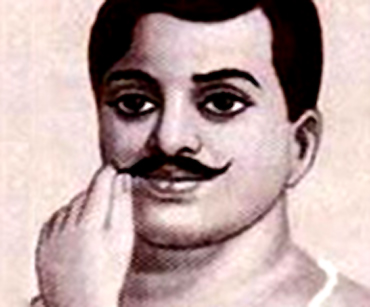
In the autumn of 1921, Chandra Shekhar Tiwari was a student of Sanskrit at the prestigious Kashi Vidyapeeth in Varanasi. A fervent call by Mahatma Gandhi, urging his countrymen to join the Non-Cooperation Movement in 1921 against the British regime, changed his life forever.
Only 15 years old, Chandra Shekhar joined the movement and was arrested by the police. In an incident that has since become part of folklore, when he was produced before the magistrate, he proudly stated that his name was "Azad'. Even in the repressive British Raj, the brave boy considered himself free.
When the magistrate enquired about his father's name, Chandra Shekhar replied "swatantra" (freedom). Exasperated by his courage, the magistrate ordered the police to subject Chandra Shekhar to 15 whip lashes.
According to the legend, with each lash, the boy shouted "Bharat Mata ki Jai".
Since that day, the boy from Jhabua in Madhya Pradesh was known as Chandra Shekhar Azad. He went on to become one of the most prominent revolutionaries in the history of India and played a major role in the armed struggle against the imperialist rule.
Gandhiji called off the Non-Cooperation Movement in 1922 after the Chauri Chaura incident. Soon, Azad started warming up to the idea of an armed revolution to overthrow the British rulers. He also believed that an Independent India would provide equal opportunities to members from all communities, castes and classes.
Chandra Shekhar Azad then joined the Hindustan Republican Association, under the leadership of revolutionary Ram Prasad Bismil.
Azad, Bismil and other freedom fighters started attacking important British officials to convey the message that it was time for the tyrannical rulers to leave. They funded their activities by robbing government properties.
Click on NEXT for more...

Azad also played a major role in training and mentoring Bhagat Singh, Rajguru and Sukhdev, who went on to become fearless revolutionaries. The trio were behind the killing of British police officer J P Saunders in Lahore in 1928. They were arrested, convicted, sentenced to death and hanged.
Azad and his fellow revolutionaries carried out the daring Kakori train robbery in 1925. They stopped the train, which was headed to Lucknow, by pulling the chain. They then overpowered the guards and fled with bags of money that belonged to the treasury.
Incensed by the train robbery and Saunders's death, the British government started an intense manhunt for members of the HRA.
On February 27, 1931, Azad was holding a meeting with fellow revolutionary Sukhdev Raj in Alfred Park, Allahabad, when they were surrounded by a contingent of policemen. In spite of being greatly outnumbered, Azad refused to surrender and killed three policemen in the ensuing gun battle. He was seriously injured when he was hit by a bullet in the leg, but continued to put up a fight, while providing cover for Sukhdev Raj to escape.
Chandra Shekhar Azad had vowed that he would never be caught alive by the British. When he realised that there was only one bullet left in his pistol, he shot himself, and died a free man.
It took 16 more years for India to attain the freedom Azad had craved so much. Though his dream of living in an independent India was never realised, selfless men like him paved the way for the freedom movement that engulfed India within a few years and ended the centuries-old British rule.
On the 106th birth anniversary of this great patriot, the least we -- a generation of Indians who enjoy our freedom without really valuing it -- can do is remember men like him who paid with their lives to achieve that very freedom.
Click on NEXT for more...
...